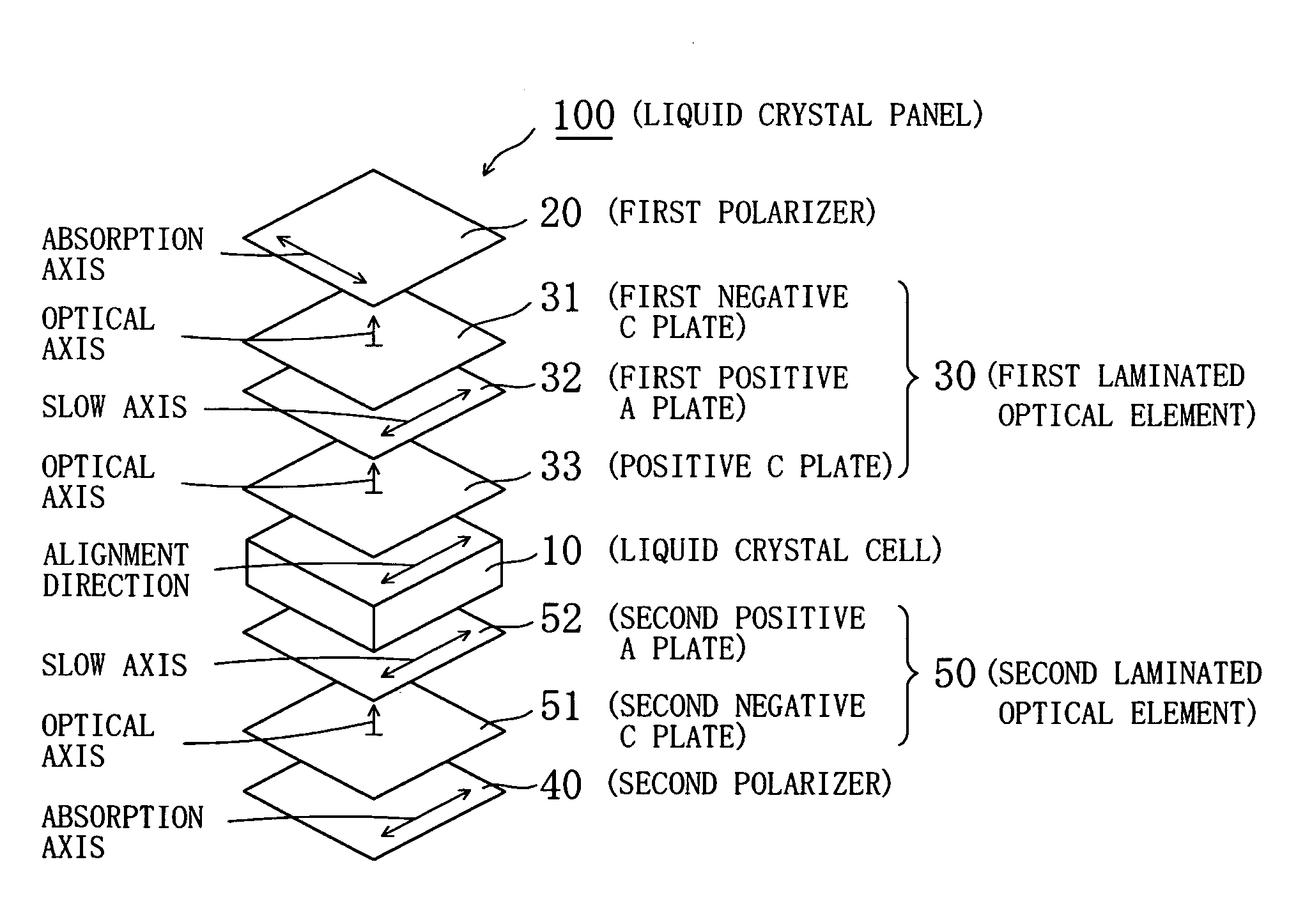Liquid Crystal Panel, Liquid Crystal Television, And Liquid Crystal Display Apparatus
a liquid crystal display and television technology, applied in the field of can solve the problems of significantly the liquid crystal display apparatus cannot operate at high temperatures, and the viewer may feel uncomfortable and tired, so as to achieve the effect of reducing the contrast ratio in an oblique direction, reducing the light leakage in an oblique direction in the black display of the liquid crystal display apparatus, and significantly increasing the contrast ratio in an obliqu
- Summary
- Abstract
- Description
- Claims
- Application Information
AI Technical Summary
Benefits of technology
Problems solved by technology
Method used
Image
Examples
reference example 1
[0276] 17.7 parts by weight of a polyetheretherketone-based resin (weight average molecular weight=520,000, average refractive index=1.56) represented by the following formula (II) is dissolved in 100 parts by weight of methyl isobutyl ketone, to thereby prepare a resin solution having a total solid content of 15 wt %. The resin solution was applied uniformly to a surface of a commercially available polyethylene terephthalate film [“Lumirror S27-E”, trade name, available from Toray Industries, Inc. (thickness of 75 μm)] by using a rod coater, and the whole was dried in an air-circulating thermostatic oven at 135° C.±1° C. for 5 minutes, and then in an air-circulating thermostatic oven at 150° C.±1° C. for 10 minutes, to thereby evaporate the solvent. The polyethylene terephthalate film was peeled off, to thereby obtain a polymer film containing as a main component a polyetheretherketone-based resin. This polymer film was referred to as a retardation film A-1. Table 1 shows propertie...
reference example 2
[0277] A polymer film containing as a main component a cycloolefin-based resin obtained through hydrogenation of a ring-opened polymer of a norbornene-based monomer [“Arton F”, trade name, available from JSR Corporation (thickness of 100 μm, glass transition temperature=171° C., average refractive index=1.51, Re[590]=5 nm, Rth[590]=18 nm)] was stretched 1.2 times in a longitudinal direction and 1.2 times in a transverse direction in an air-circulating thermostatic oven at 190° C.±2° C. by using a biaxial stretching machine (longitudinal and transverse sequential biaxial stretching). The obtained stretched film was referred to as a retardation film A-2. Table 1 shows the properties of the retardation film A-2.
reference example 3
[0278] A commercially available polymer film containing as a main component triacetyl cellulose [“Fujitac”, trade name, available from Fuji Photo Film, Co., Ltd. (thickness of 80 μm, average refractive index=1.48)] was used as it is. This polymer film was referred to as a retardation film A-3. Table 1 shows the properties of the retardation film A-3.
TABLE 1ReferenceReferenceReferenceExample 1Example 2Example 3Retardation filmA-1A-2A-3Thickness (μm)3.68080Transmittance (%)929292Re[590] (nm)0.20.61.0Rth[590] (nm)305480C[590]× 10−12 (m2 / N)78.317.85.0
PUM
| Property | Measurement | Unit |
|---|---|---|
| pretilt angle | aaaaa | aaaaa |
| thickness | aaaaa | aaaaa |
| thickness | aaaaa | aaaaa |
Abstract
Description
Claims
Application Information
 Login to View More
Login to View More - R&D
- Intellectual Property
- Life Sciences
- Materials
- Tech Scout
- Unparalleled Data Quality
- Higher Quality Content
- 60% Fewer Hallucinations
Browse by: Latest US Patents, China's latest patents, Technical Efficacy Thesaurus, Application Domain, Technology Topic, Popular Technical Reports.
© 2025 PatSnap. All rights reserved.Legal|Privacy policy|Modern Slavery Act Transparency Statement|Sitemap|About US| Contact US: help@patsnap.com



